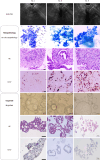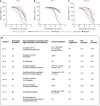Strategic insights into the cultivation of pancreatic cancer organoids from endoscopic ultrasonography-guided biopsy tissue
- PMID: 39563744
- PMCID: PMC11572629
- DOI: 10.3748/wjg.v30.i42.4532
Strategic insights into the cultivation of pancreatic cancer organoids from endoscopic ultrasonography-guided biopsy tissue
Abstract
Background: The frequent suboptimal efficacy of endoscopic ultrasound-guided fine-needle biopsy (EUS-FNB) to culture pancreatic cancer (PC) organoids (PCOs) poses a major challenge in the advancement of personalized medicine for advanced PC.
Aim: To explore how to obtain appropriate puncture tissues from EUS-FNB and optimize the strategy for efficiently constructing PCOs, providing an efficient tool for the advancement of personalized medicine.
Methods: Patients who underwent EUS-FNB for the diagnosis of PC tissue were prospectively enrolled. We refined the endoscopic biopsy procedures and organoid cultivation techniques. All tissue specimens verified by on-site pathological assessment were cultured in a semi-suspended medium in a microfluidic environment. We assessed differences in PCOs cultured beyond and below five generations examining patient demographics, specimen and organoid attributes, and the sensitivity of organoids to a panel of clinical drugs through cell viability assays.
Results: In this study, 16 patients with PC were recruited, one sample was excluded because onsite cytopathology showed no tumor cells. Successful organoid generation occurred in 93.3% (14 of 15) of the EUS-FNB specimens, with 60% (9 of 15) sustaining over five generations. Among these patients, those with a history of diabetes, familial cancer, or larger tumors exhibited enhanced PCO expandability. The key factors influencing long-term PCOs expansion included initial needle sample quality (P = 0.005), rapid initiation of organoid culture post-isolation (P ≤ 0.001), and high organoid activity (P = 0.031). Drug sensitivity analysis revealed a partial response in two patients following therapeutic intervention and surgery and stable disease in four patients, indicating a moderate correlation between organoid response and clinical outcomes.
Conclusion: Optimal initial needle sampling, rapid and precise biopsy sample processing, process isolated samples as soon as possible, and sufficient cellular material are crucial for successful cultivating PCOs. High organoid activity is an important factor in maintaining their long-term expansion, which is essential for shortening the time of drug sensitivity analysis and is the basis of PC research.
Keywords: Cultivation optimization strategy; Drug screening; Endoscopic ultrasound-guided fine-needle biopsy; Pancreatic cancer organoid; Puncture technique.
©The Author(s) 2024. Published by Baishideng Publishing Group Inc. All rights reserved.
Conflict of interest statement
Conflict-of-interest statement: The authors declare that there is no conflict of interest.
Figures




Similar articles
-
Successful creation of pancreatic cancer organoids by means of EUS-guided fine-needle biopsy sampling for personalized cancer treatment.Gastrointest Endosc. 2018 Jun;87(6):1474-1480. doi: 10.1016/j.gie.2017.12.032. Epub 2018 Jan 9. Gastrointest Endosc. 2018. PMID: 29325707 Free PMC article.
-
Standardized Methods Using EUS-guided Fine-needle Biopsy and a Minimal Medium Creates Three Pancreatic Cancer Organoids.Anticancer Res. 2022 Aug;42(8):4103-4109. doi: 10.21873/anticanres.15908. Anticancer Res. 2022. PMID: 35896269
-
A Comparative Study of the Diagnostic Utility of Endoscopic Ultrasound-Guided Fine Needle Aspiration Cytology (EUS-FNA) versus Endoscopic Ultrasound-Guided Fine Needle Biopsy (EUS-FNB) in Pancreatic and Non-Pancreatic Lesions.Asian Pac J Cancer Prev. 2022 Jun 1;23(6):2151-2158. doi: 10.31557/APJCP.2022.23.6.2151. Asian Pac J Cancer Prev. 2022. PMID: 35763660 Free PMC article. Clinical Trial.
-
Comprehensive review on endoscopic ultrasound-guided tissue acquisition techniques for solid pancreatic tumor.World J Gastroenterol. 2023 Mar 28;29(12):1863-1874. doi: 10.3748/wjg.v29.i12.1863. World J Gastroenterol. 2023. PMID: 37032729 Free PMC article. Review.
-
Current status of newer generation endoscopic ultrasound core needles in the diagnostic evaluation of gastrointestinal lesions.J Am Soc Cytopathol. 2020 Sep-Oct;9(5):389-395. doi: 10.1016/j.jasc.2020.05.006. Epub 2020 Jun 5. J Am Soc Cytopathol. 2020. PMID: 32680792 Review.
Cited by
-
Applications and challenges of patient-derived organoids in hepatobiliary and pancreatic cancers.World J Gastroenterol. 2025 May 28;31(20):106747. doi: 10.3748/wjg.v31.i20.106747. World J Gastroenterol. 2025. PMID: 40495940 Free PMC article. Review.
References
-
- Nakai Y, Chang KJ. EUS-guided fine-needle injection for pancreatic cancer: back to the future. Gastrointest Endosc. 2020;92:1053–1054. - PubMed
MeSH terms
LinkOut - more resources
Full Text Sources
Medical

